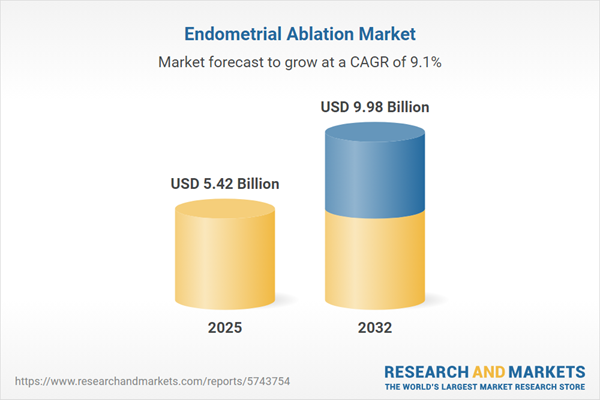Speak directly to the analyst to clarify any post sales queries you may have.
The endometrial ablation market is transforming with technological innovations and changing clinical protocols, offering senior healthcare decision-makers new opportunities to optimize patient outcomes and operational efficiency within gynecology practices. This strategic summary presents actionable insights for clinicians, procurement leaders, and executives seeking to capitalize on evolving trends in minimally invasive women’s health solutions.
Market Snapshot: Endometrial Ablation Market Overview
The Endometrial Ablation Market grew from USD 4.95 billion in 2024 to USD 5.42 billion in 2025. It is expected to continue growing at a CAGR of 9.14%, reaching USD 9.98 billion by 2032. This robust trajectory is propelled by rising demand for effective, minimally invasive interventions for excessive uterine bleeding, increased clinician adoption, and an expanding aging female demographic. Stakeholders are responding to both clinical needs and cost efficiency imperatives as they integrate advanced platforms into care pathways.
Scope & Segmentation
- Distribution Channels: Direct sales; distributor partnerships.
- Procedure Approaches: Hysteroscopic; nonhysteroscopic methods.
- Applications: Endometrial hyperplasia; fibroid ablation; heavy menstrual bleeding management; targeted polyp removal.
- End Users: Ambulatory surgical centers; clinics; hospitals.
- Technologies: Cryoablation; hydrothermal ablation; microwave ablation; radiofrequency ablation; thermal balloon ablation.
- Age Groups: 35–44; 45–54; 55–64; above 64.
- Regions: Americas (United States, Canada, Mexico, Brazil, Argentina, Chile, Colombia, Peru), Europe (United Kingdom, Germany, France, Russia, Italy, Spain, Netherlands, Sweden, Poland, Switzerland), Middle East (United Arab Emirates, Saudi Arabia, Qatar, Turkey, Israel), Africa (South Africa, Nigeria, Egypt, Kenya), and Asia-Pacific (China, India, Japan, Australia, South Korea, Indonesia, Thailand, Malaysia, Singapore, Taiwan).
- Companies: Hologic, Inc.; Olympus Corporation; Medtronic plc; CooperSurgical, Inc.; Boston Scientific Corporation; Smith & Nephew plc; GE HealthCare Technologies Inc.; Stryker Corporation; Becton, Dickinson and Company; B. Braun Melsungen AG.
Key Takeaways: Strategic Insights for Decision-Makers
- Increasing preference for minimally invasive ablation procedures supports a shift away from hysterectomies for excessive uterine bleeding.
- Enhanced device designs, user-friendly procedural techniques, and digital integration are improving precision, clinician workflow, and patient comfort.
- Collaboration among device manufacturers, healthcare providers, and payers is vital to overcome reimbursement and cost-effectiveness challenges.
- Growth in aging female populations and benign uterine conditions highlights ongoing demand for scalable ablative solutions across outpatient and inpatient settings.
- Regional regulatory frameworks and evolving training programs are accelerating adoption rates and shaping competitive dynamics globally.
- Integration of cloud analytics and telehealth platforms enables remote patient engagement, improved post-operative care, and data-driven clinical improvement initiatives.
Tariff Impact: Navigating 2025 Supply Chain Dynamics
Upcoming United States tariff adjustments in 2025 are expected to impact acquisition costs, sourcing decisions, and supply chain resilience for endometrial ablation device manufacturers. Providers and procurement teams are weighing total cost of ownership and alternative procedural options as manufacturers localize production, form strategic supply agreements, and optimize inventory management. Staying agile in regulatory compliance and operational planning remains critical to maintain access and affordability across clinical settings.
Methodology & Data Sources
The insights presented are derived from a systematic review of peer-reviewed medical literature, clinical trial registries, industry databases, and government publications. In-depth interviews with gynecology experts and medical device engineers provided additional qualitative perspectives. Data triangulation and regional expert input ensured the robustness and validity of findings.
Why This Report Matters
- Gain a comprehensive view of emerging technologies and competitive landscapes to inform high-level investment and procurement strategies.
- Identify outcome-driven opportunities to enhance care quality, cost efficiency, and patient satisfaction across diverse healthcare models.
Conclusion
The endometrial ablation market is experiencing a dynamic evolution shaped by innovation, regulatory shifts, and regional forces. Informed, agile strategies will empower leaders to drive sustainable growth, elevate care standards, and capture new opportunities as the sector advances.
Additional Product Information:
- Purchase of this report includes 1 year online access with quarterly updates.
- This report can be updated on request. Please contact our Customer Experience team using the Ask a Question widget on our website.
Table of Contents
3. Executive Summary
4. Market Overview
7. Cumulative Impact of Artificial Intelligence 2025
Companies Mentioned
The companies profiled in this Endometrial Ablation market report include:- Hologic, Inc.
- Olympus Corporation
- Medtronic plc
- CooperSurgical, Inc.
- Boston Scientific Corporation
- Smith & Nephew plc
- GE HealthCare Technologies Inc.
- Stryker Corporation
- Becton, Dickinson and Company
- B. Braun Melsungen AG
Table Information
| Report Attribute | Details |
|---|---|
| No. of Pages | 197 |
| Published | October 2025 |
| Forecast Period | 2025 - 2032 |
| Estimated Market Value ( USD | $ 5.42 Billion |
| Forecasted Market Value ( USD | $ 9.98 Billion |
| Compound Annual Growth Rate | 9.1% |
| Regions Covered | Global |
| No. of Companies Mentioned | 11 |









